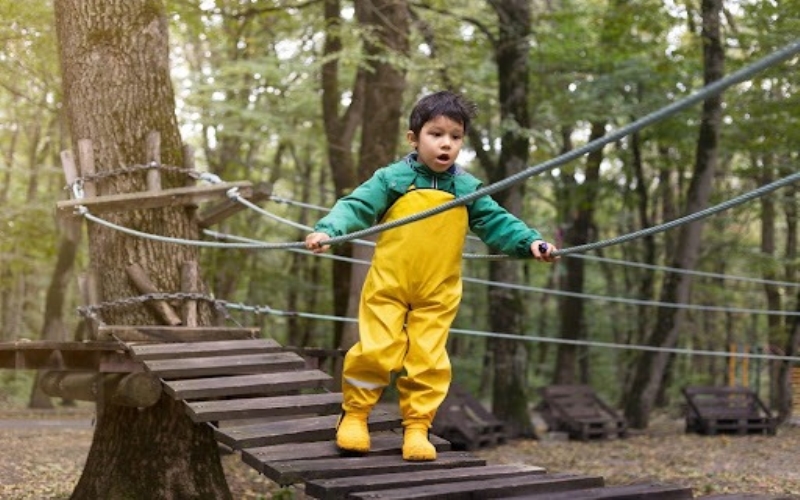An obstacle path is fun to get your youngsters active and interact with their trouble-solving competencies. Obstacle guides assist in enhancing coordination, power, flexibility, and cardiovascular health. They also provide a creative outlet and train teamwork if you have multiple children. The excellent element is you could construct an impediment route using not unusual family items and set it up indoors or outside.
Where to Build Your Obstacle Course?
When selecting where to set up your DIY impediment route, look for an area that offers sufficient room for exclusive stations and sports. Good options encompass:
- Backyard
- Basement
- Garage
- Local park
- Living room with furniture moved
If creating an outdoor obstacle course, ensure the area has a soft ground cover like grass or mulch versus concrete or asphalt. This helps prevent injuries from falls. For more fun you can do Hiking in Virginia beach and experience the level of outdoor challenging activities while connecting with nature.
Obstacles to Include
The fun of the obstacle course runs through various challenges. Use what you add to get creative based on your location and equipment. Ideas include:
- Balance beam – Use a 2×4 board or draw a line on the ground.
- Bear crawl – Crawl on hands and feet sideways under a pole or rope set at an appropriate height.
- Climb over – Use a pile of sturdy boxes or playground equipment.
- Crawl through – Set up a tent or tunnel made from chairs and blankets.
- Hurdles – Jump over poles, sticks, or plastic cones.
- Ladder walk – Place a ladder flat on the ground and have kids walk across the rungs.
- Limbo – Use a broomstick and have kids go under it backward.
- Jump rope – Use a single rope to leap over.
- Kick the ball under – Roll a ball and chase after it to kick it.
- Pool noodle balance – Walk across pool noodles resting on the ground.
- Toss rings or bean bags – Toss onto targets like cones.
- Water crossing – Use a kiddie pool or lay down a tarp filled with water.
- Zig zag cones – Run in a zig-zag pattern through a line of cones.
You can also incorporate tasks like throwing balls at targets, carrying cups of water across the course without spilling, and other fun physical activities. Rotate obstacles periodically to keep it exciting and challenging.
Set the Course Layout
Lay out your obstacle course design before setting up equipment. Measure the total space you have and sketch obstacles in the area. Place barriers at least 6 feet apart for safety.
Try to put obstacles in some logical order and flow where one activity leads smoothly to the next. When ready, use chalk, markers, or tape to designate obstacle locations and boundaries.
Have kids help set up and tear down the course to build their independence and give them ownership—store equipment in a bin for quick setup next time.
Safety Tips
While obstacle courses involve some physical risk, there are ways to reduce the chances of injury. Follow these tips:
- Check equipment for sharp edges, splinters, or breakage.
- Set age-appropriate challenges. Have more accessible options for younger kids.
- Remind kids to take turns and wait if someone is at an obstacle.
- Ensure adult supervision at all times.
- No pushing or rough play.
- Explain the proper form for challenges like ladder crossings.
- Remind kids to stop activity if they feel dizzy or short of breath.
- Check that footing is stable before balancing any obstacles.
- Pour water on the tarp “rivers” and re-wet periodically to avoid slipping.
- Have a first aid kit nearby for minor scrapes and falls.
Getting Kids Engaged
Your kids will be eager to try a new obstacle course, but their interest may wane. Try these ideas to keep them motivated and actively participating:
- Time trials – Use a stopwatch to see if they can beat their best time on the course.
- Partner races – Complete the course side-by-side with a sibling or friend.
- Blindfolded challenge – Have one child wear a blindfold and be verbally guided by a partner.
- Add themes – Decorate the course with a colourful theme like pirates, superheroes, or princesses.
- Mix up the activities – Rotate in new obstacles and remove others to create variety.
- Offer rewards – Small prizes like stickers or treats for completing a certain number of obstacle laps.
- Music – Play fun, motivating music in the background as they move through the course.
- Show off skills – Have a family member record a video of kids in action to share proudly with relatives.
Wrap Up
An escape room obstacle course built from everyday household items offers an easy way to encourage physical activity that engages kids’ minds and bodies. Rotate simple challenges tailored to your available space. Maintain safety guidelines, add variety periodically, and include interactive elements to enthuse your children. An obstacle course is a creative outlet you and your kids will come back to again and again for active fun right at home.

